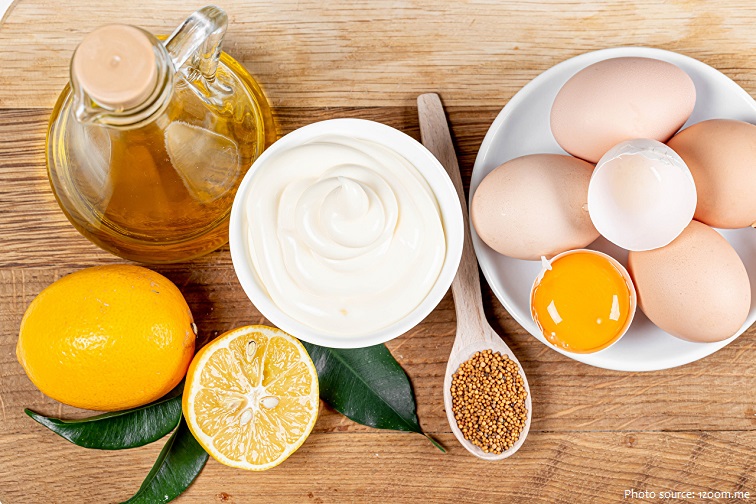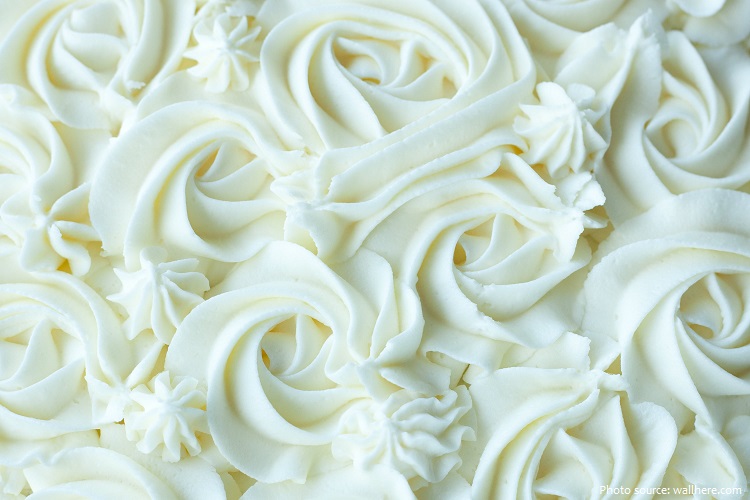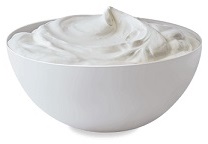
Cream is a dairy product.
Fresh unpasteurised milk quickly separates and the fat rises to the top. This fat layer is then skimmed off and is known as cream.
Cream produced by cattle grazing on natural pasture often contains some natural carotenoid pigments derived from the plants they eat – this gives it a slightly yellow tone, hence the name of the yellowish-white color: cream. This is also the origin of butter’s yellow color. Cream from goat’s
milk, water buffalo milk, or from cows fed indoors on grain or grain-based pellets, is white.
Cream skimmed from milk may be called “sweet cream” to distinguish it from cream skimmed from whey, a by-product of cheese-making. Whey cream has a lower fat content and tastes more salty, tangy and “cheesy”.

Cream has long been a versatile ingredient in the kitchen and can form a base to desserts, such as posset, or can be added to both sweet and savoury sauces to create a rich, smooth texture. Cream is also served just as it is, poured or spooned over hot or cold puddings and used as a garnish for
soups.
There are few different types of creams available:
Single cream is a richer version of milk, with around 18% fat content. You can use it for pouring or adding to coffee. Single cream will not whip and will curdle if boiled, so it can’t be a substitute in recipes that call for whipping or double cream.
Whipping cream has around a 36% fat content, which allows air to be trapped when whipped, roughly doubling the volume. Once whipped, it can be used to top desserts or fill cakes and pastries. Whipped cream, with or without flavorings, was known as “snow cream” or “milk snow” until the 17th century. Thanks to the Oxford English Dictionary, we do know that the term “whipped cream” first appeared in 1673, while the French term for it, “crème fouettée,” appeared even earlier, in 1629.

Double cream is the thickest with around 48% fat content. It makes an ideal pouring cream, such as when serving with fruit, or it can be whipped and piped for decorating desserts. It can also be used to add richness and creaminess to savoury dishes. Extra thick double cream is made by heating then rapidly cooling double cream.
Sour cream has been treated with lactic acid, which gives it a tangy taste. It has a thick texture but only around 18% fat content. Sour cream’s history dates back to the first half of the 20th century, and is associated with the cooking traditions of Eastern Europe, Russia, Ukraine and Germany.
Use it for making cheesecakes, dips, topping nachos, and in soups and sauces, but it cannot be boiled or it will spilt.

Créme fraîche is similar to soured cream but with a milder taste. It is traditionally made from unpasteurised cream that has been left to ferment, but nowadays, pasteurised cream is thickened and soured with the addition of bacteria. It has around 48% fat, which means it does not curdle when
cooked. The name crème fraîche is French, but similar soured creams are found in much of northern Europe. A literal translation of crème fraîche is “fresh cream”. It is served with fresh fruit and in soups, casserole and dips.
Clotted cream has the highest fat percentage of all creams at 55%. It’s made by baking double cream until a delicious crust forms on the surface. Although its origin is uncertain, the cream’s production is commonly associated with dairy farms in southwest England and in particular the
counties of Cornwall and Devon.
Smetana is a heavy cream derived (15–40% milk fat) Central and Eastern European sweet or sour cream.
Rjome or rømme is Norwegian sour cream containing 35% milk fat, similar to Icelandic sýrður rjómi.
The French word crème denotes not only dairy cream, but also other thick liquids such as sweet and savory custards, which are normally made with milk, not cream.
A product known as “plastic” cream can be produced from certain types of milk separators. This product has a fat content approaching 80% fat, but it remains as an oil-in-water emulsion (the fat is still in the form of globules and the skim milk is the continuous phase of the emulsion), unlike butter
which also has a fat content of 80% but which has been churned so that the fat occupies the continuous phase and the skim milk is dispersed throughout in the form of tiny droplets (a water-in-oil emulsion).
Irish cream is a cream liqueur based on Irish whiskey, cream and other flavourings. It typically has an ABV (alcohol by volume) level of 15 to 20% and is served on its own or in mixed drinks, most commonly Irish coffee. Its largest markets are the United Kingdom, Canada and the United States. It
is not a traditional Irish product, as the first version of it, Baileys, was invented by a creative agency working for International Distillers & Vintners’s Dublin office in 1973. Within the European Union, Irish cream is a protected geographical indicator product that must be produced in Ireland.

